How to completely remove bamboo
Not sure how to deal with bamboo? We’re here to help with advice and to provide a complete removal package.
Bamboo is a growing problem in the UK, and while it is completely unregulated, thousands of people each year experience damage to their gardens, buildings, and driveways caused by this aggressive family of plants.
Dubbed by experts as “the next Japanese knotweed”, problematic varieties of bamboo should be carefully controlled or removed.
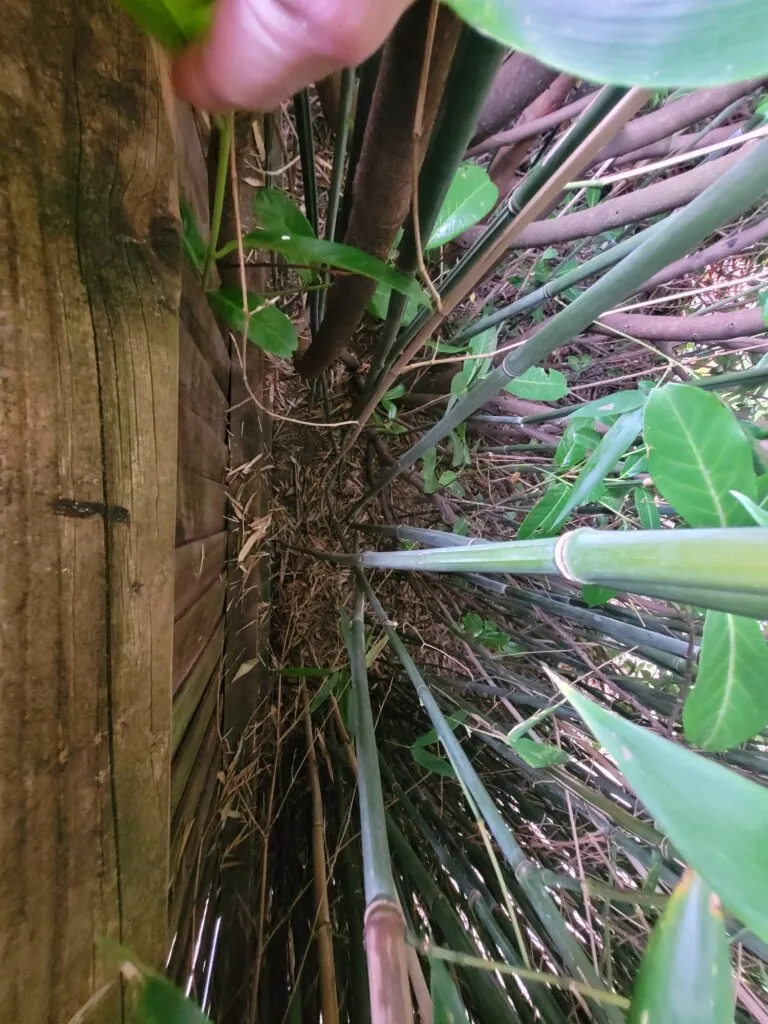
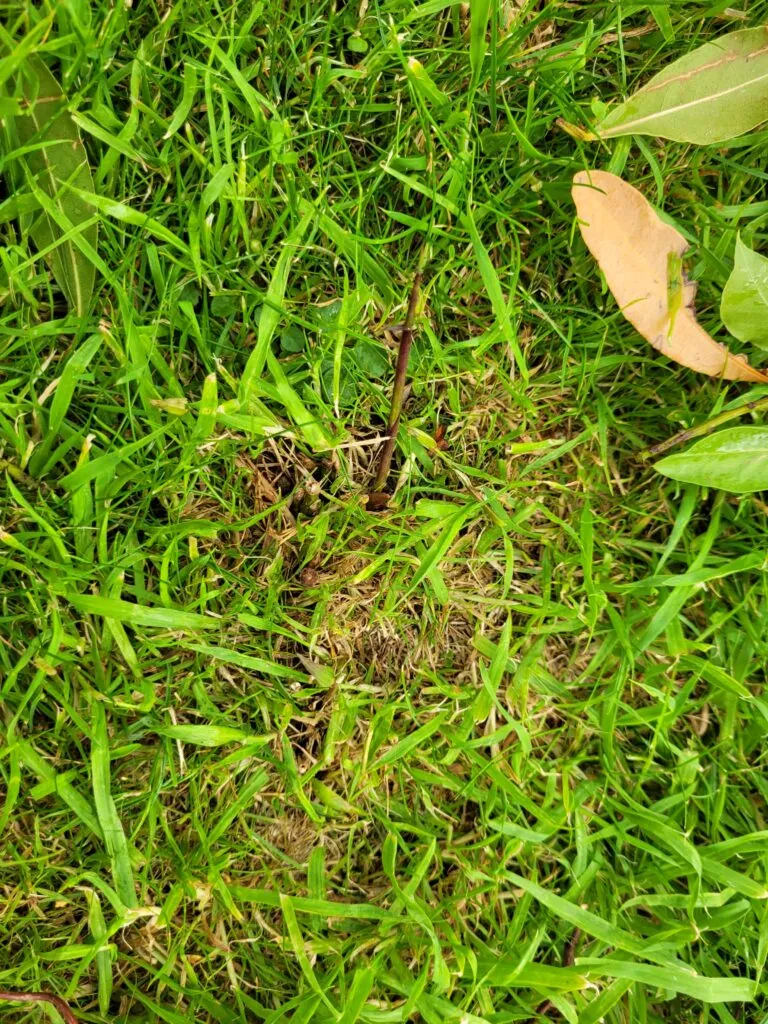
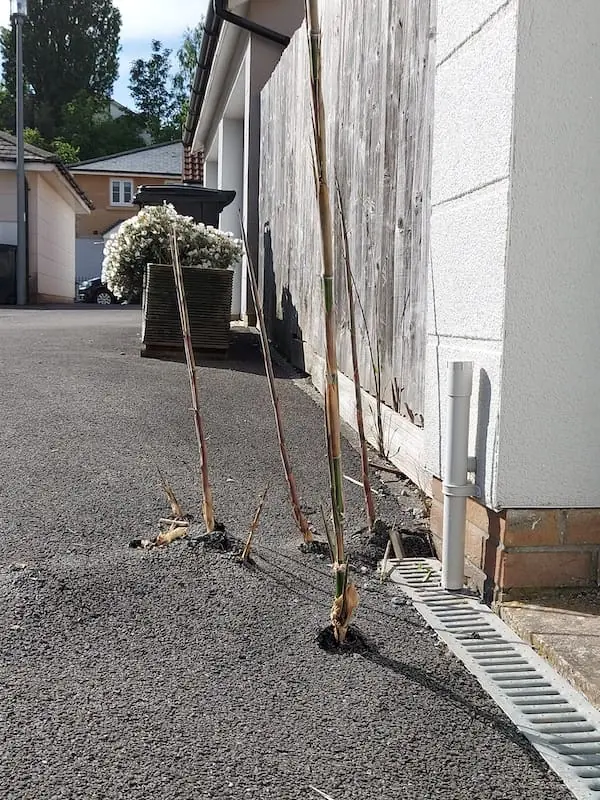
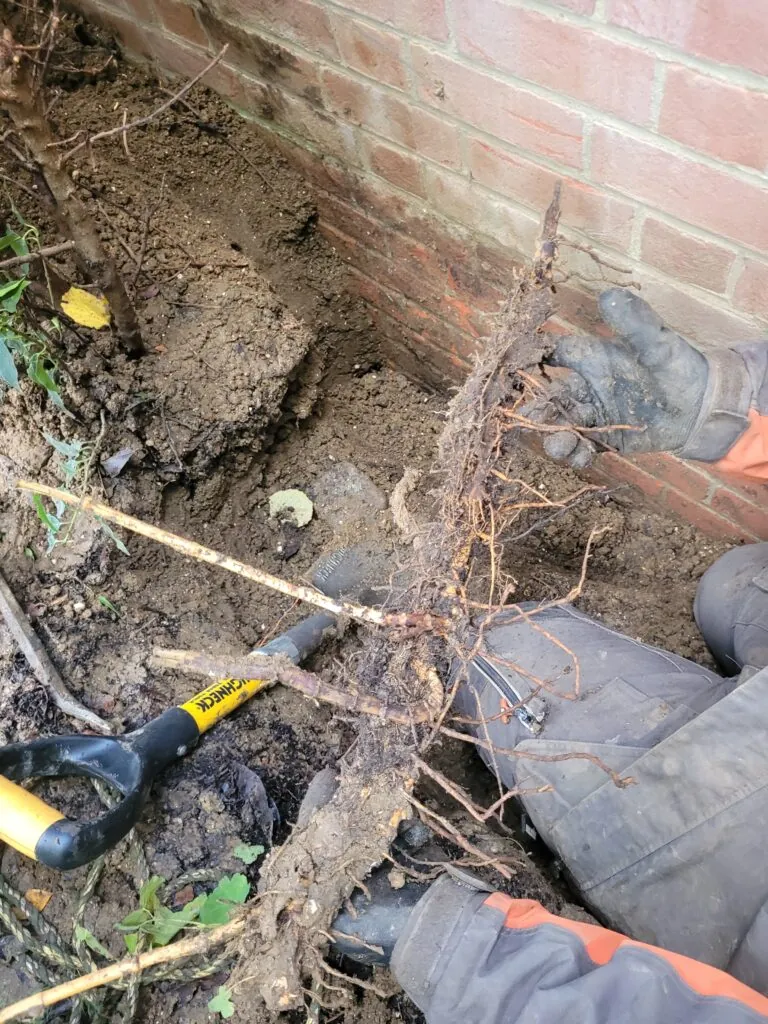
Problems with bamboo
Although bamboo provides great architectural planting in a garden setting and acts as a cost-effective screen, selecting the wrong variety or inheriting it can soon lead to difficulties. If you start to see warning signs like bamboo emerging outside of the original planting area, acting quickly will save you huge costs in the long run. It’s not unusual to start experiencing problems with bamboo about 7-10 years after planting it.
- Bamboo can quickly spread into unwanted areas, taking over flower beds, lawns, and patios.
- The root balls and runners of bamboo are very tough and can be extremely difficult to remove using everyday garden hand tools once they are established.
- The tough runners can exploit gaps and weaknesses in structures and can quickly cause significant damage.
- When bamboo spreads into an adjoining property, it can lead to disputes and even legal action between neighbours, especially if it causes damage.
What damage is caused by bamboo?
The reason bamboo is so damaging is because individual bamboo culms emerge from the ground at their full diameter from nodes along the runners. When you combine this with the fact that some bamboo can travel over 10m from the parent plants, you can quickly find yourself in difficulty.
- Lawns and flowerbeds can be overrun.
- Overlying structures such as driveways and patios are easily damaged by both underground runners and emerging culms.
- Bamboo can penetrate buildings, growing into cavity walls, through floor voids, and into services like drains.
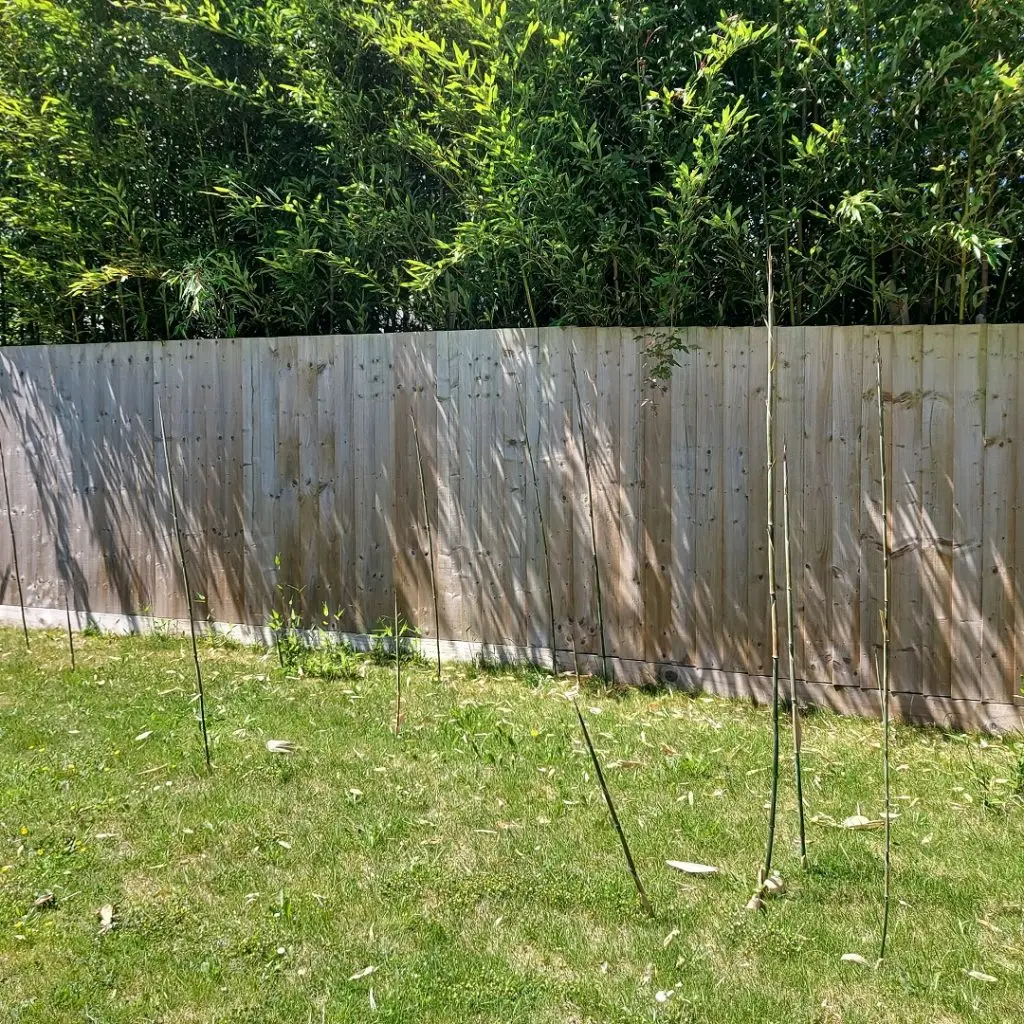
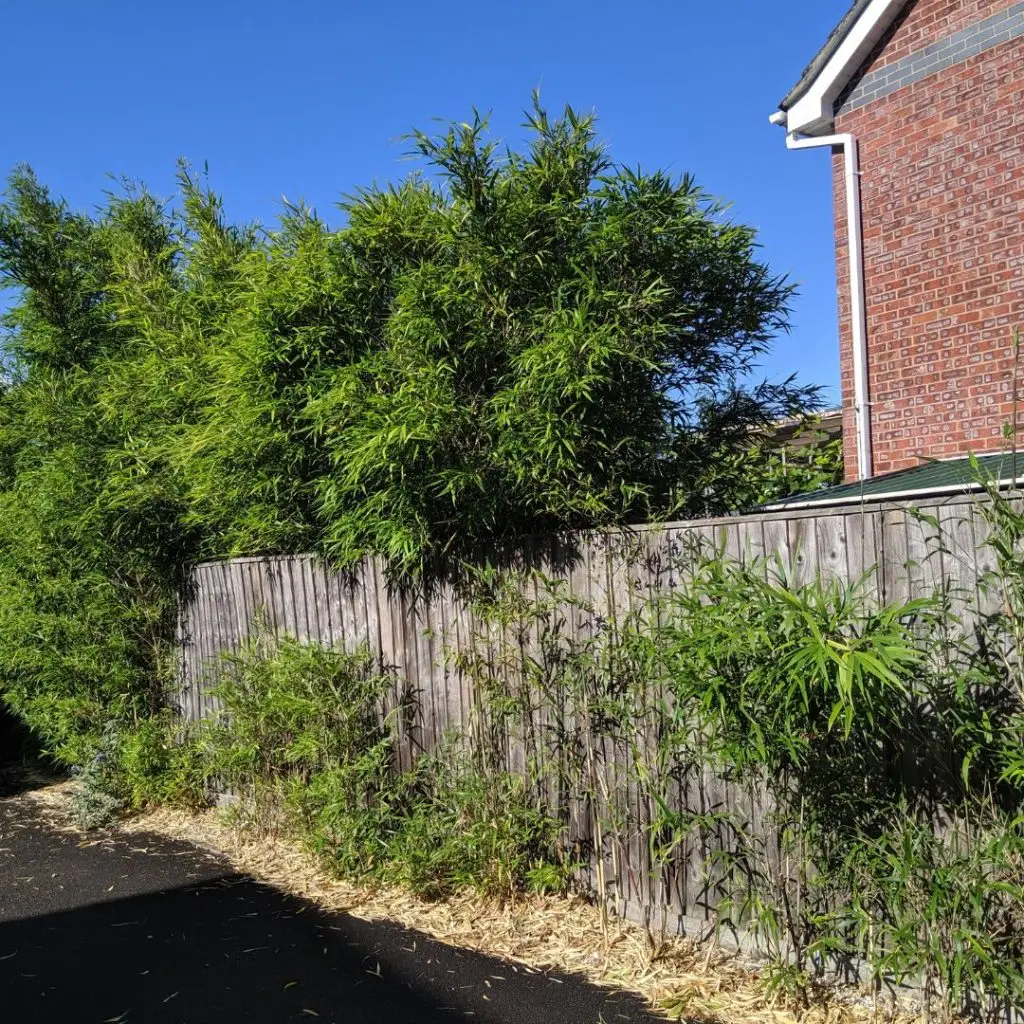
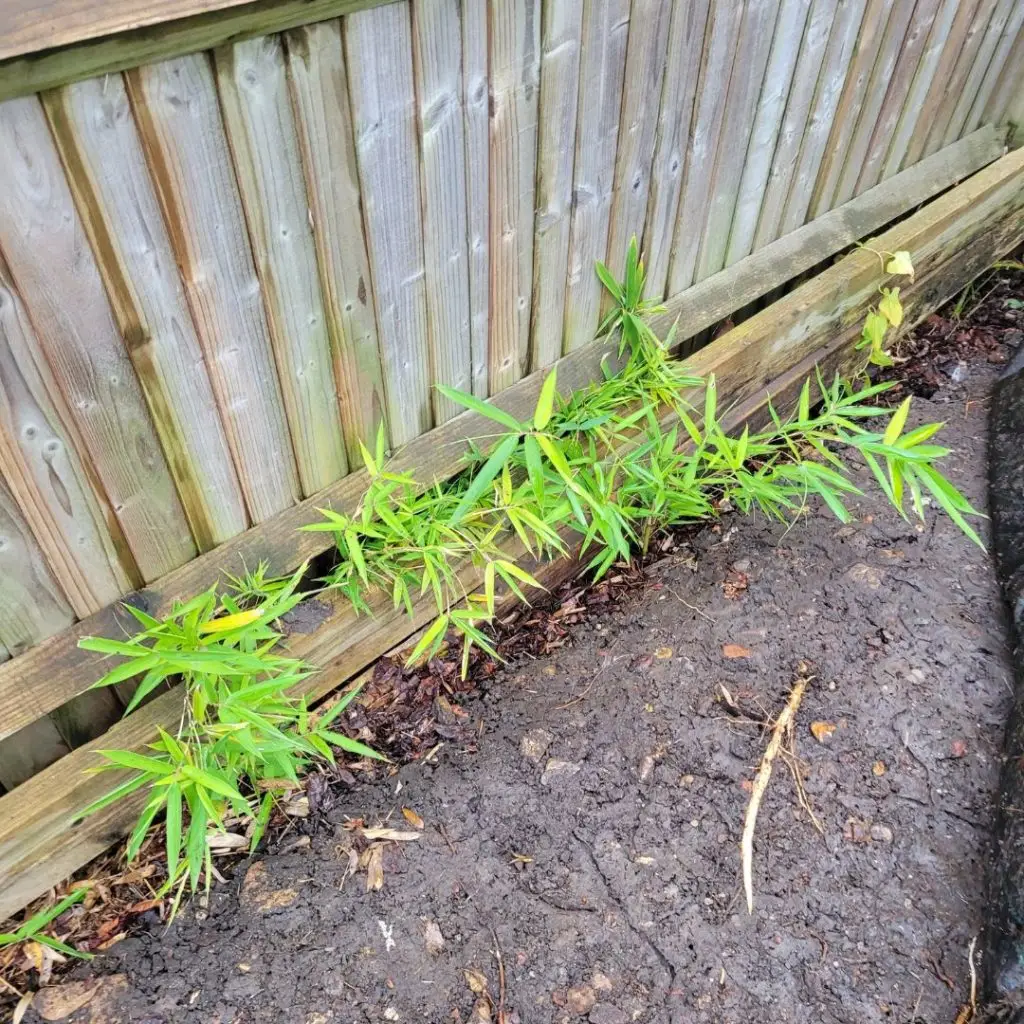
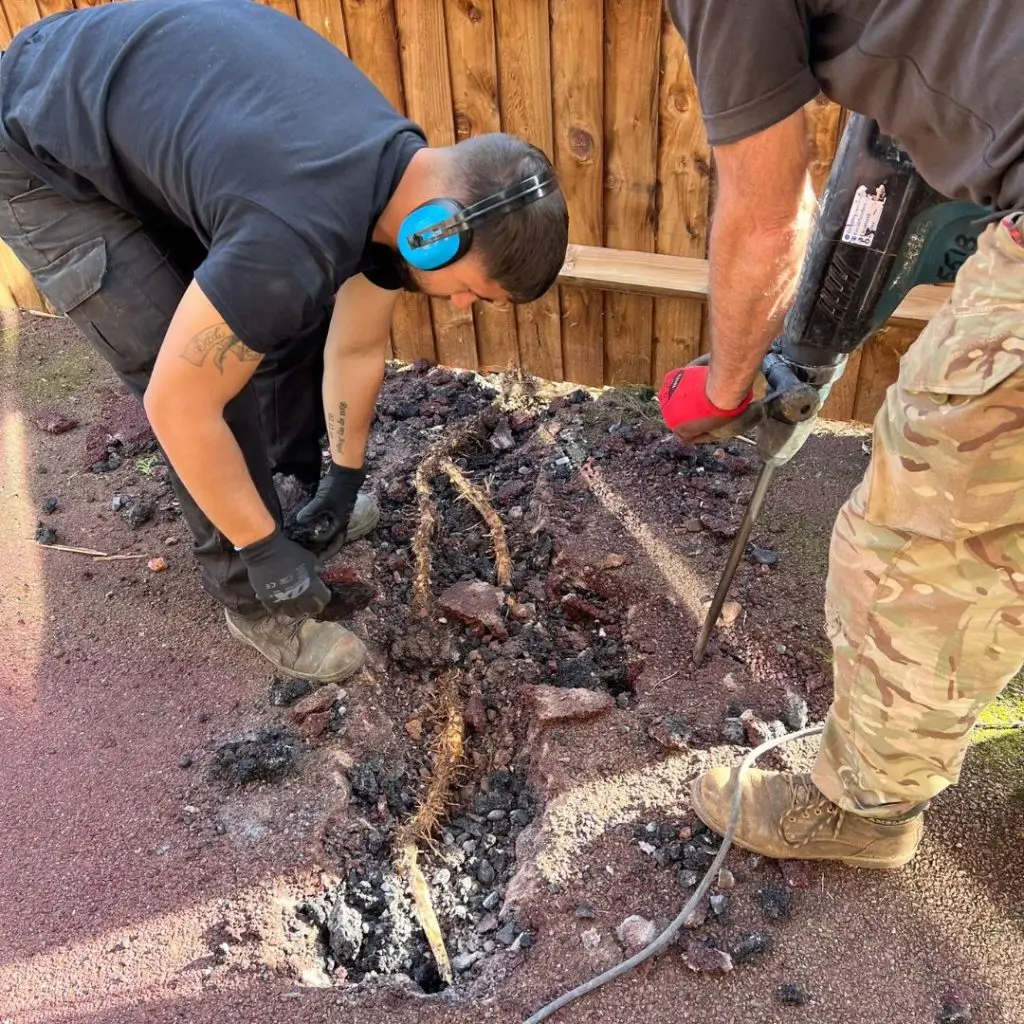
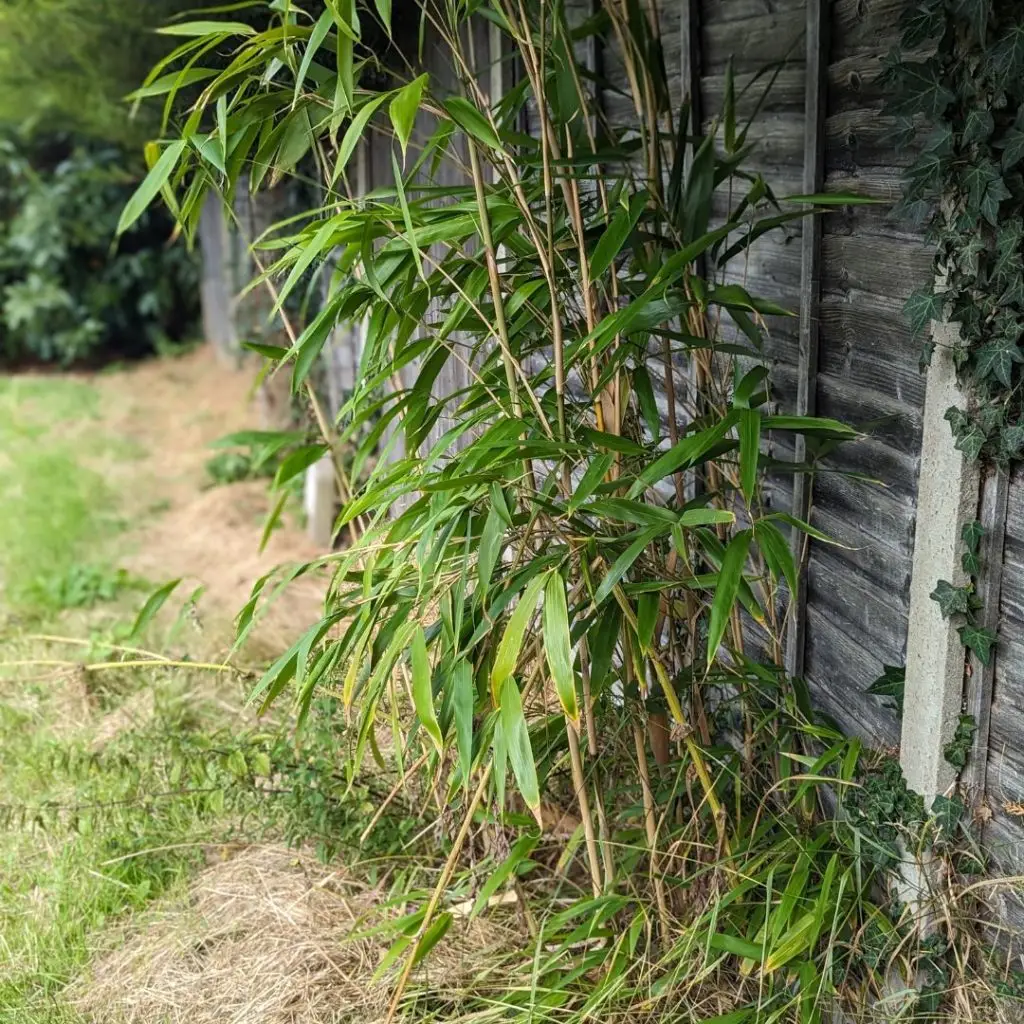
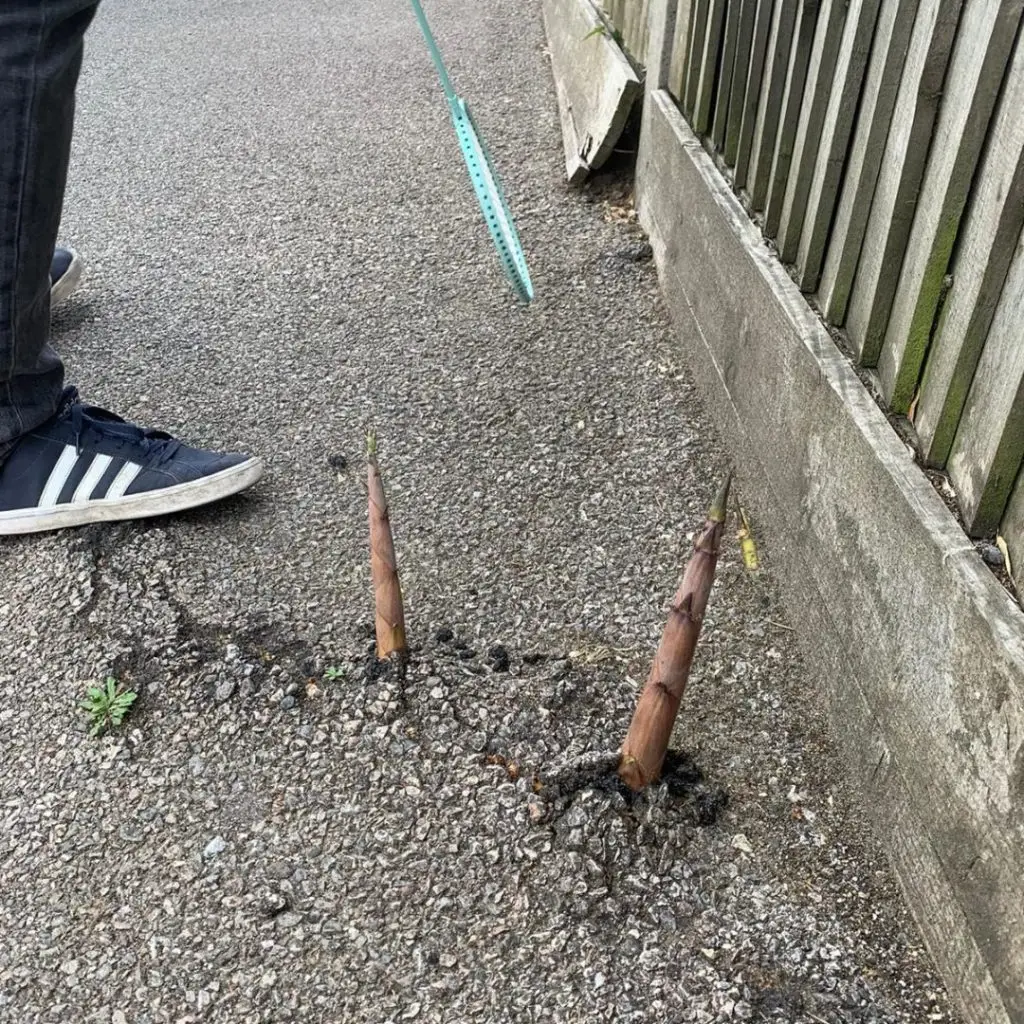
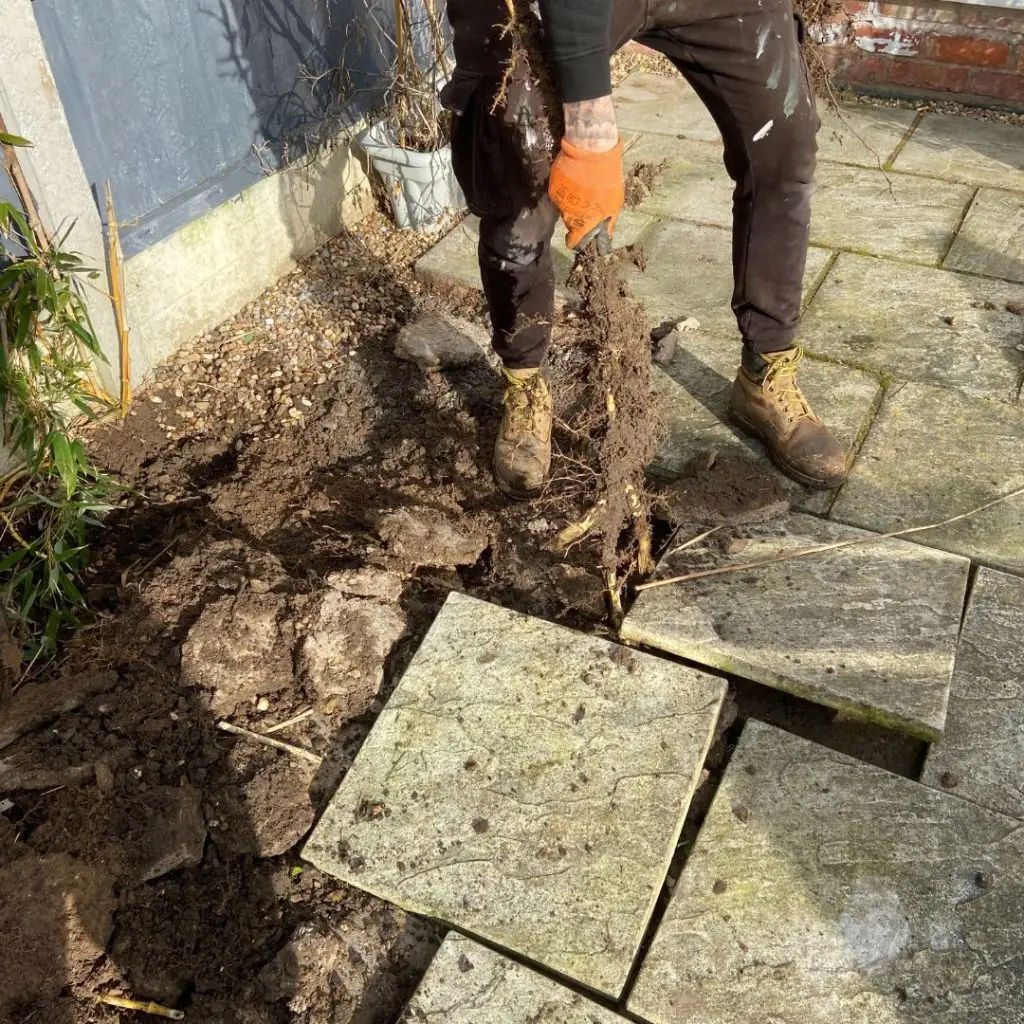
Bamboo encroachment
One of the main problems with bamboo is where it spreads into neighbouring properties. Given that bamboo is often used to provide privacy on boundaries, this may not come as too much of a surprise.
Bamboo spreads quickly, and can cause all kinds of damage, so it’s important you keep an eye on it and are aware of the consequences if you ignore it.
It isn’t illegal to have bamboo growing on your property, but when it spread across boundaries into adjoining properties it can cause damage, negatively impact values and prompt legal disputes between neighbours. Legal cases relating to bamboo are already on the rise and we anticipate they will increase further as awareness grows.
Read our FAQs below if you are suffering from encroachment.
Identification
Over 1,400 varieties of bamboo exist, that fall into two different growth patterns – “clumping” and “running”. Both types can have large underground rhizome systems. However, the running types normally pose the most problems. This is because they send out long lateral rhizomes that can spread several meters from the parent plants. Want to know if your bamboo is a bad one? You can find all the information in our complete guide to bamboo identification.

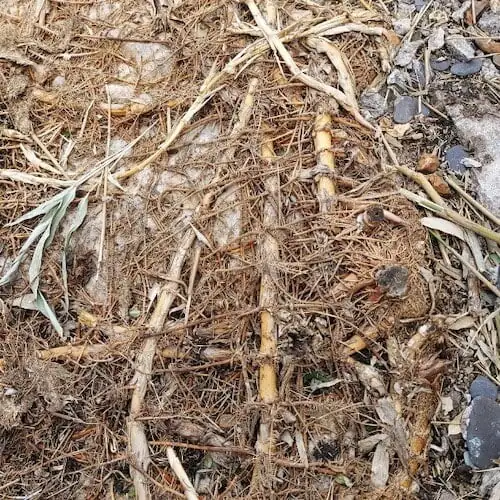
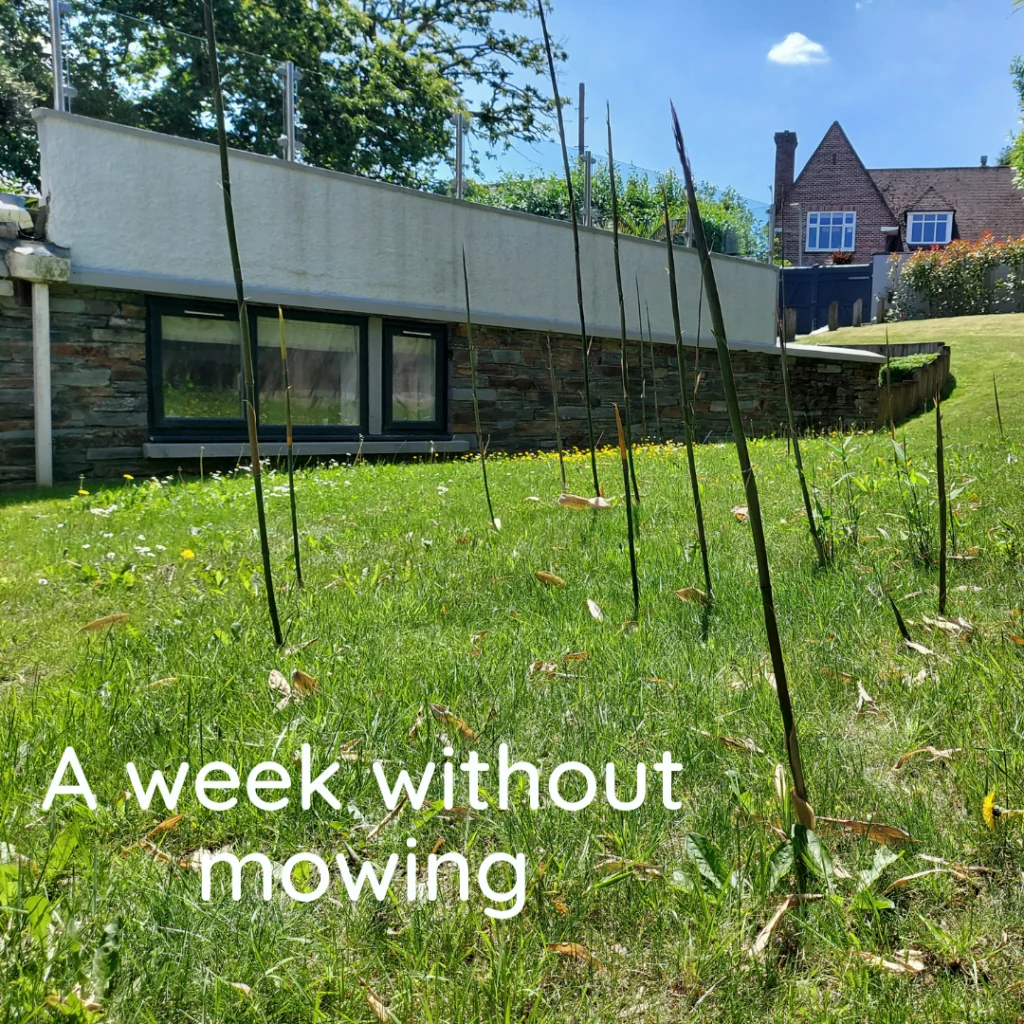
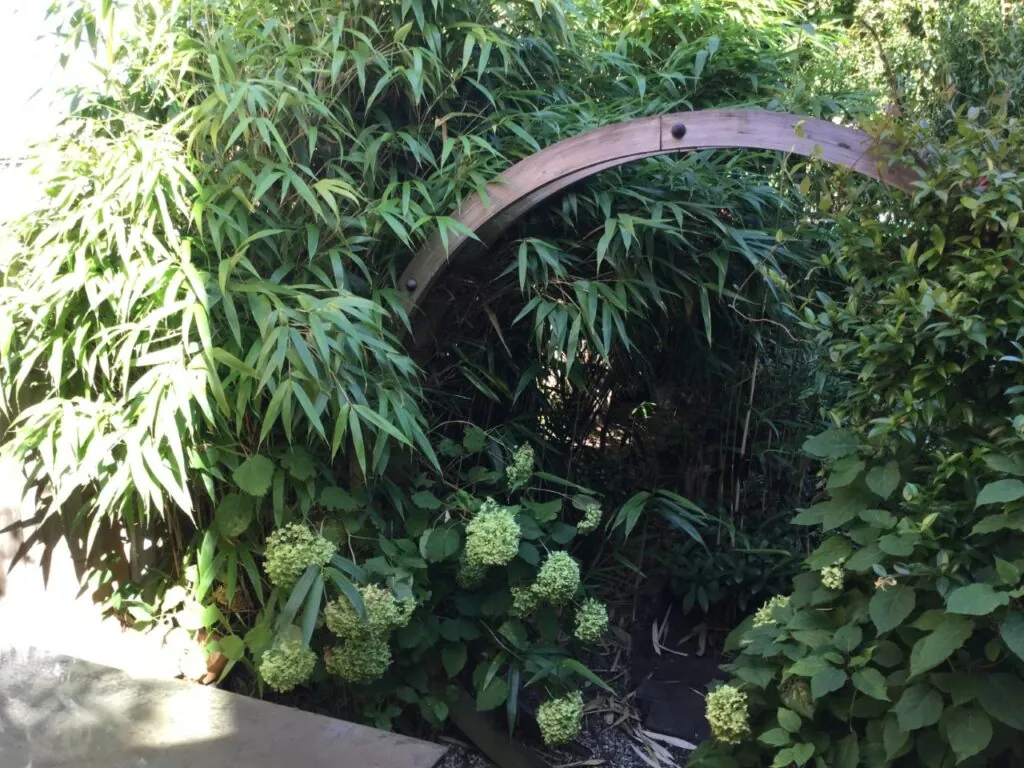
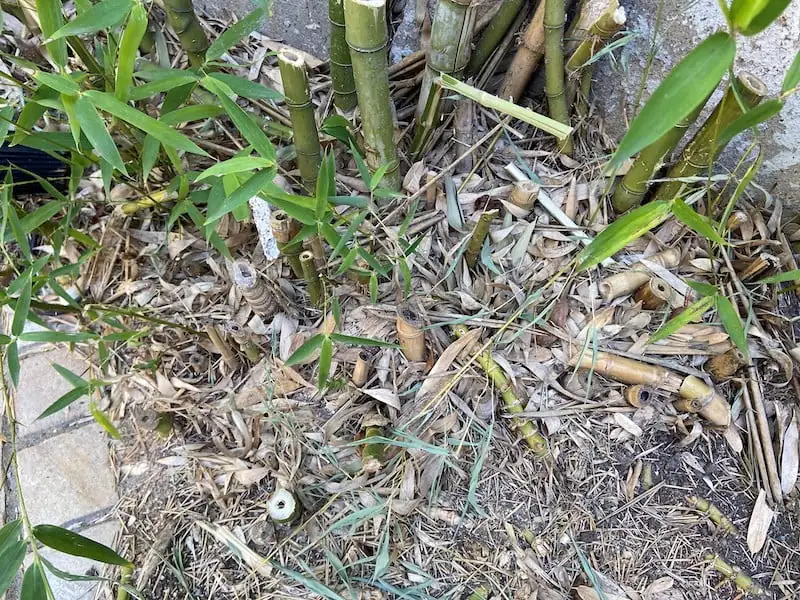
How to get rid of bamboo
Bamboo can be difficult to remove due to its unique growth characteristics and the structure of its root system. There are two main types of bamboo: clumping and running. Each brings its own challenges when trying to effectively remove bamboo from your garden.
Running bamboo:
– Rhizome system: Running bamboo spreads through an underground network of rhizomes, which are horizontal stems that can grow rapidly and extend several meters from the main plant. These rhizomes can be quite tenacious and challenging to remove, especially if they’ve travelled beneath paths and patios, through lawns, or other plants.
– Resilience: Bamboo rhizomes are resilient and can survive adverse conditions. Even if you cut or mow the bamboo above ground, the rhizomes will continue to produce new shoots. Even when severed from the parent plant, rhizomes can continue to produce new shoots for years.
Clumping bamboo:
– Tight root mass: While clumping bamboo tends to have a more contained growth pattern, it can still be challenging to remove because of the dense and interconnected root mass. The roots can form a tight clump that resists easy extraction.
It is important to bear in mind that larger and older clumps of bamboo can be more challenging to remove than younger ones. The size and age of the bamboo can contribute to the overall difficulty of the removal process.
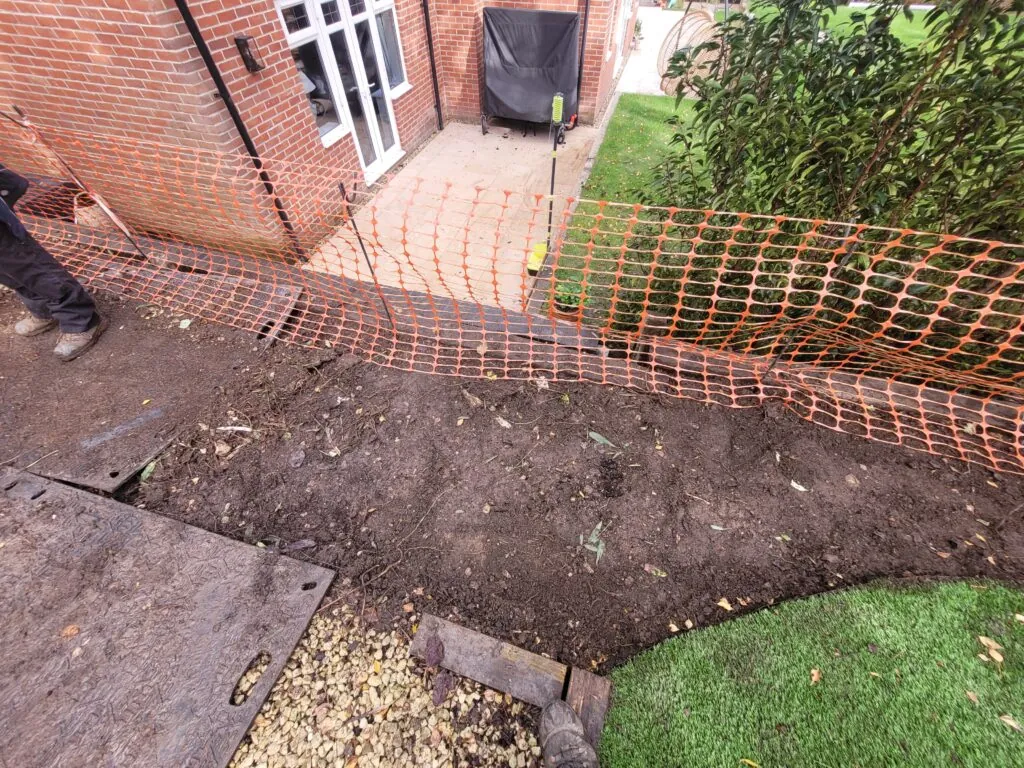
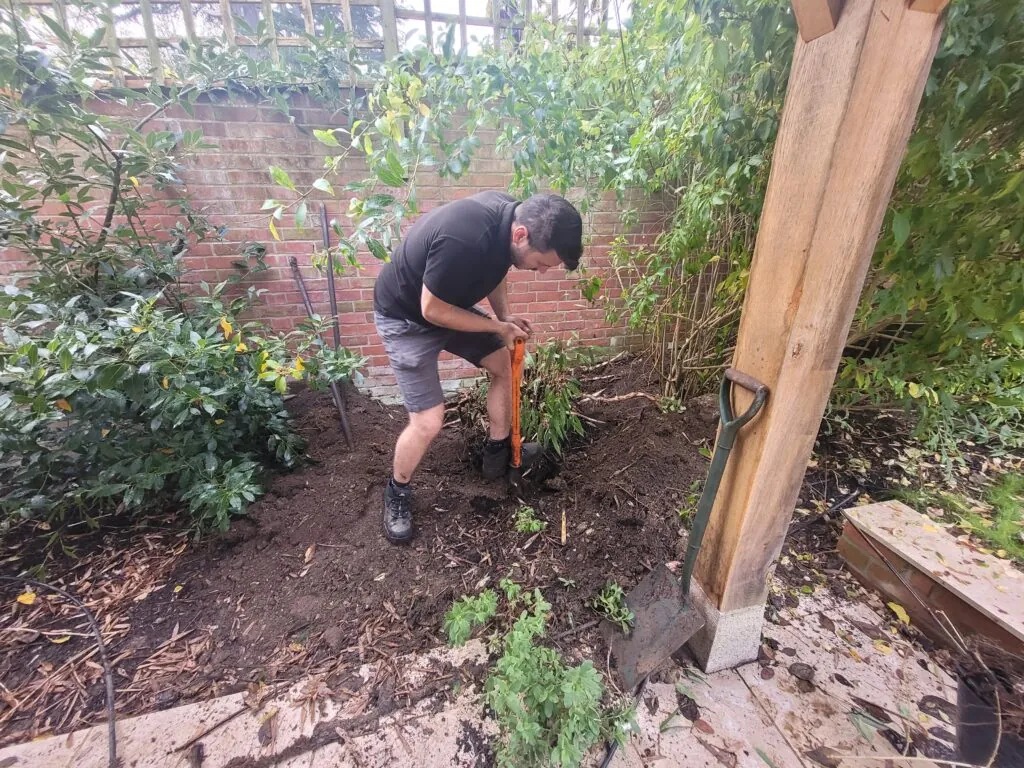
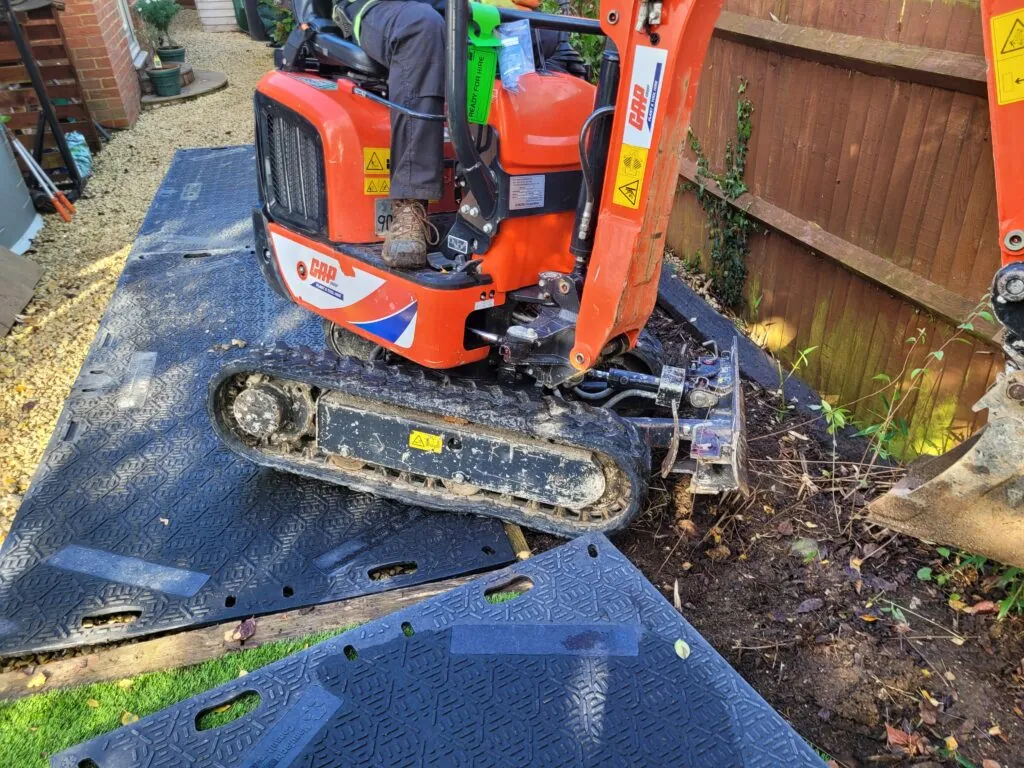
Bamboo removal methods
Cutting and digging: One common method is to cut down the bamboo canes and then dig out the rhizomes. This process can be labour-intensive, especially if the bamboo has spread over a large area.
Herbicides: Some people resort to using herbicides to kill bamboo. However, this may require multiple applications, and there is a risk of harming other plants and microorganisms in the vicinity.
Barrier installation: Installing physical barriers (such as bamboo rhizome barriers made of plastic or metal) can help contain the spread of bamboo. These barriers need to be installed deep into the ground to prevent the rhizomes from escaping.
Tips for bamboo removal:
- Persistence: Bamboo removal often requires persistence and ongoing efforts. Even if you remove the visible shoots, you may need to monitor and address new growth.
- Thorough removal: It’s essential to remove as much of the rhizome system as possible to prevent regrowth.
- Professional help: In many cases, especially with extensive bamboo infestations, seeking professional assistance will be the most effective solution.
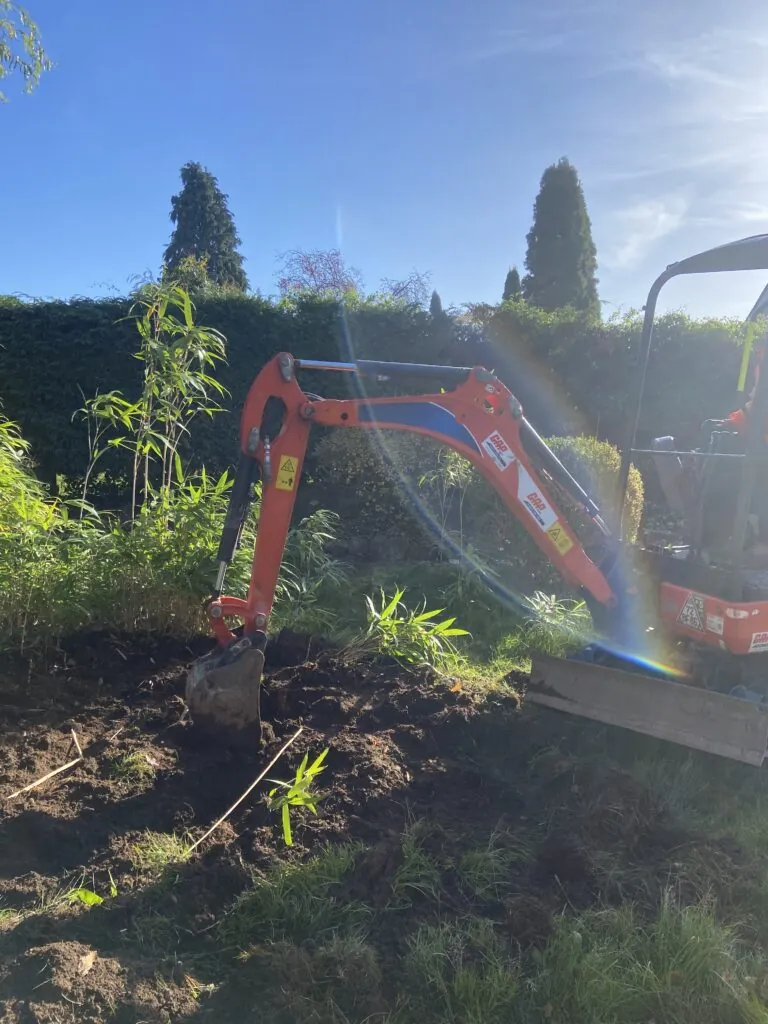
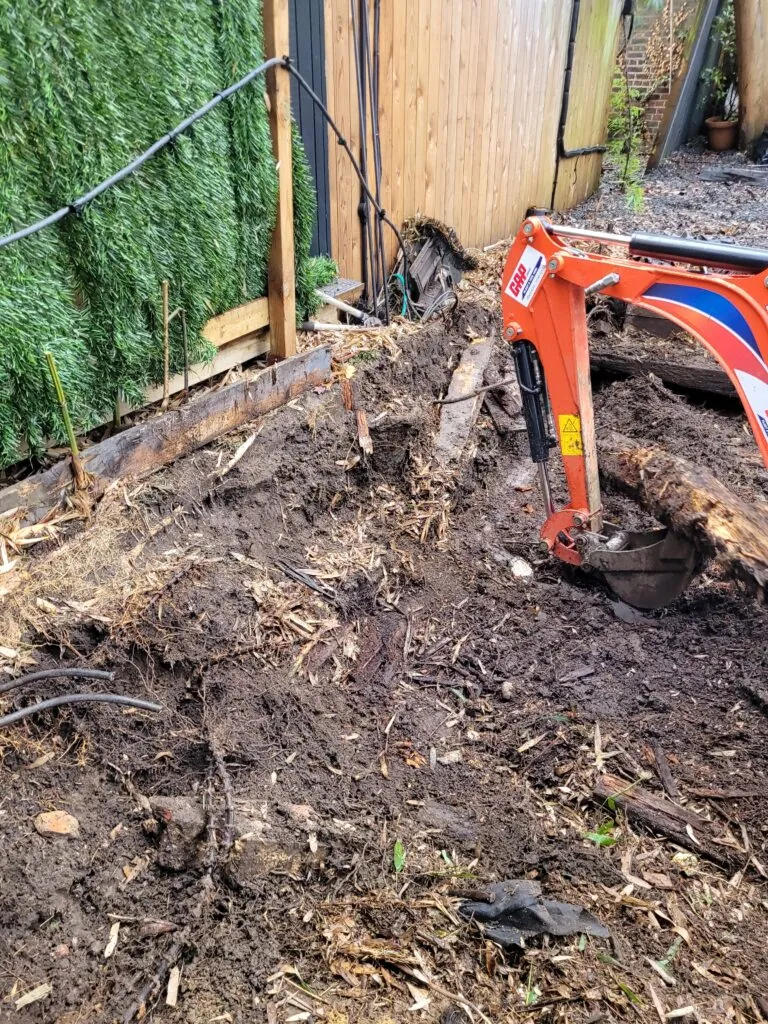
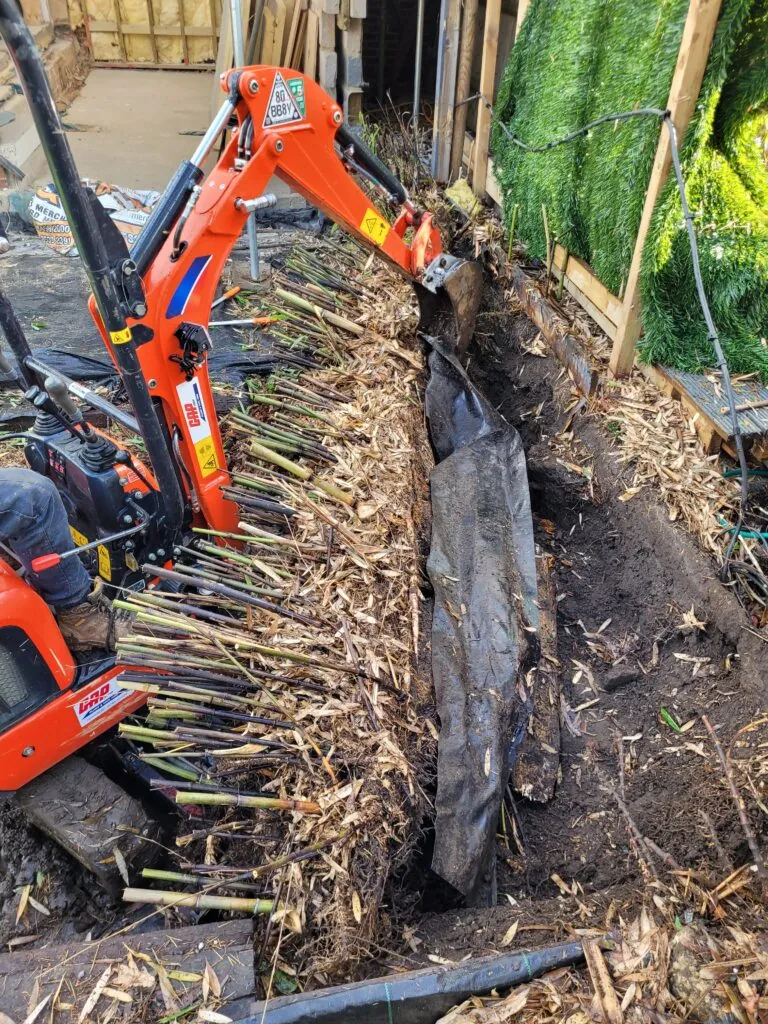
Professional bamboo removal
At Environet, we’re used to tackling problematic invasive weeds – and a few decades of experience in removing and controlling them means we are well-equipped to deal with this garden brute.
We specialise in situations that prove too much of a challenge for homeowners or their gardeners or where guarantees are required. Prices start from £2,300 + VAT but typically range from £4,000 – £6,500 + VAT on residential properties.
Before we can identify the best solution for your property, we will need to undertake a comprehensive survey. A survey will assess the type, spread, and damage that the bamboo has caused, along with other practical aspects such as access, service locations, and reinstatement work that will be needed. The survey also gives you the chance to ask our experts any questions you might have.
Bamboo removal:
Our approach is to excavate and remove all the offending root/rhizome system. For mature stands, a lot of soil can be affected, so it’s no easy job. However, we’ve been successfully using a similar method on Japanese knotweed for over 25 years, so for us, bamboo removal is relatively straightforward.
Bamboo containment:
Sometimes our customers want to retain some of the bamboo to provide useful shelter or privacy from neighbours – for this reason, we offer containment and reduction solutions using vertical root barrier membranes to prevent the bamboo from spreading into areas where you don’t want it to grow. The lateral runners can then be removed by physical excavation – these can be 30 ft long or more, but don’t worry, we can still remove them.
Bamboo herbicide:
The use of herbicides on bamboo is effective for small stands, and for small sections of runners that cannot otherwise be practicably removed by mechanical means. We find that herbicide has limited effect on well-established bamboo, and in any case, leaves behind the root mass that will ultimately need removing anyway. For this reason, we do not normally opt for herbicide as a recommended option for killing bamboo.
Insurance-Backed
Bamboo Guarantees
What makes our insurance-backed guarantee market-leading?
The ONLY company in the UK able to offer this level of protection
“AA-” rated insurer accepted by all major lenders
Up to £100,000 limit of liability
Cover effective in days – no delays
Up to 10 years’ cover
No excess charges
Fully assignable
Minimal restrictions
The nature of invasive plants, and their incredible regenerative power, means that despite all best endeavours, some viable rhizomes may remain in the ground after our works have been completed. As part of our commitment to you, our work comes with a 12-month monitoring period as standard, during which we will complete monitoring to check for regrowth.
For ultimate peace of mind, many of our clients, opt for a 5 or 10-year insurance-backed guarantee.
While insurance-backed guarantees are not yet compulsory when it comes to selling like they are for knotweed, they provide you with cast iron protection for your investment and also serve to reassure buyers that the risk associated with regrowth is fully covered, no matter what.
Prevent costly damage to your property
Before & After
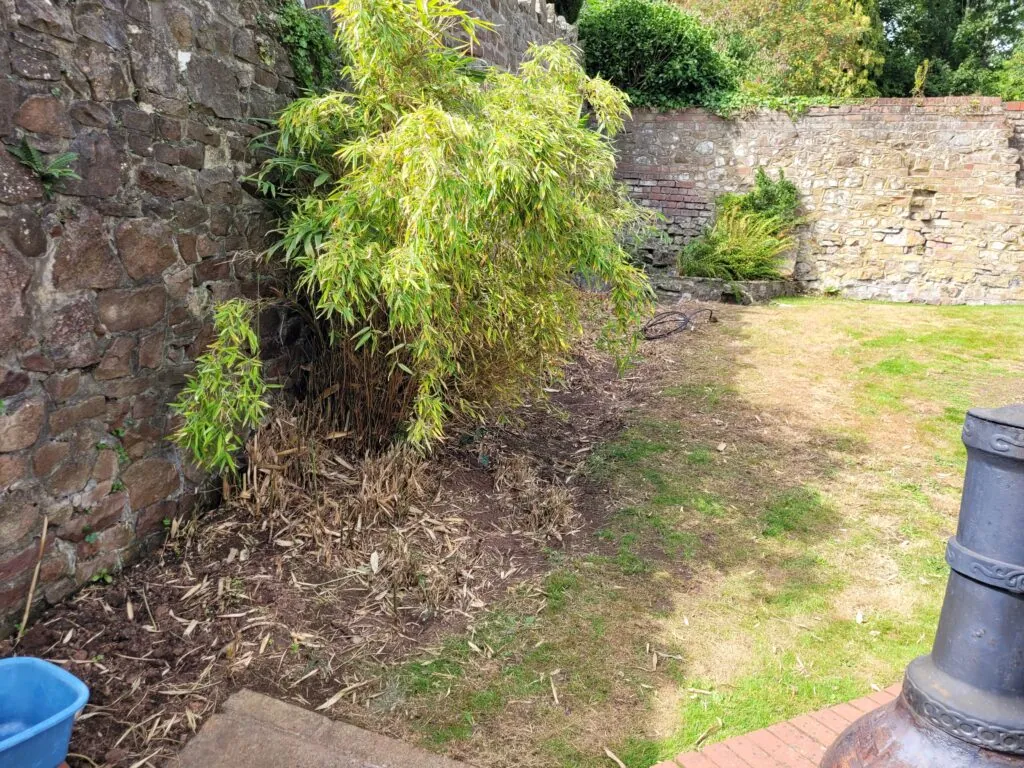
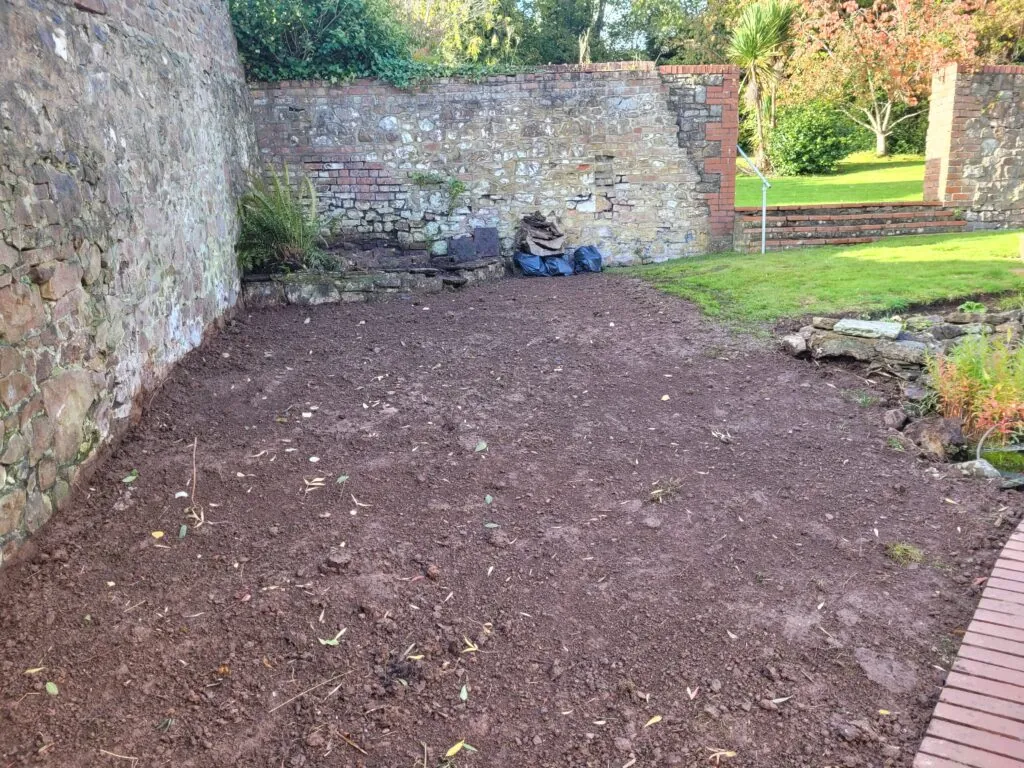
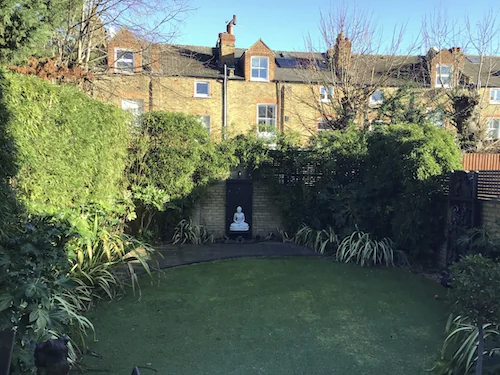

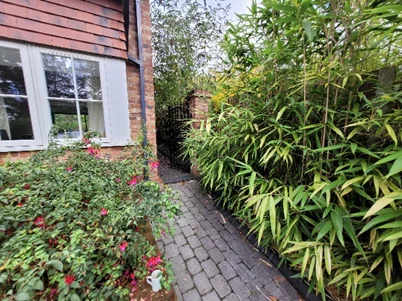
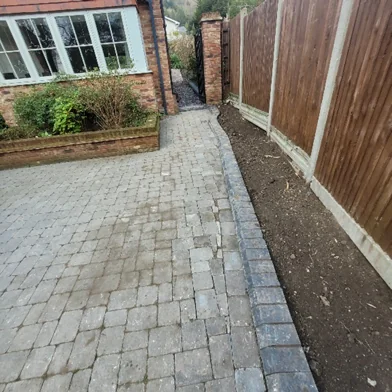
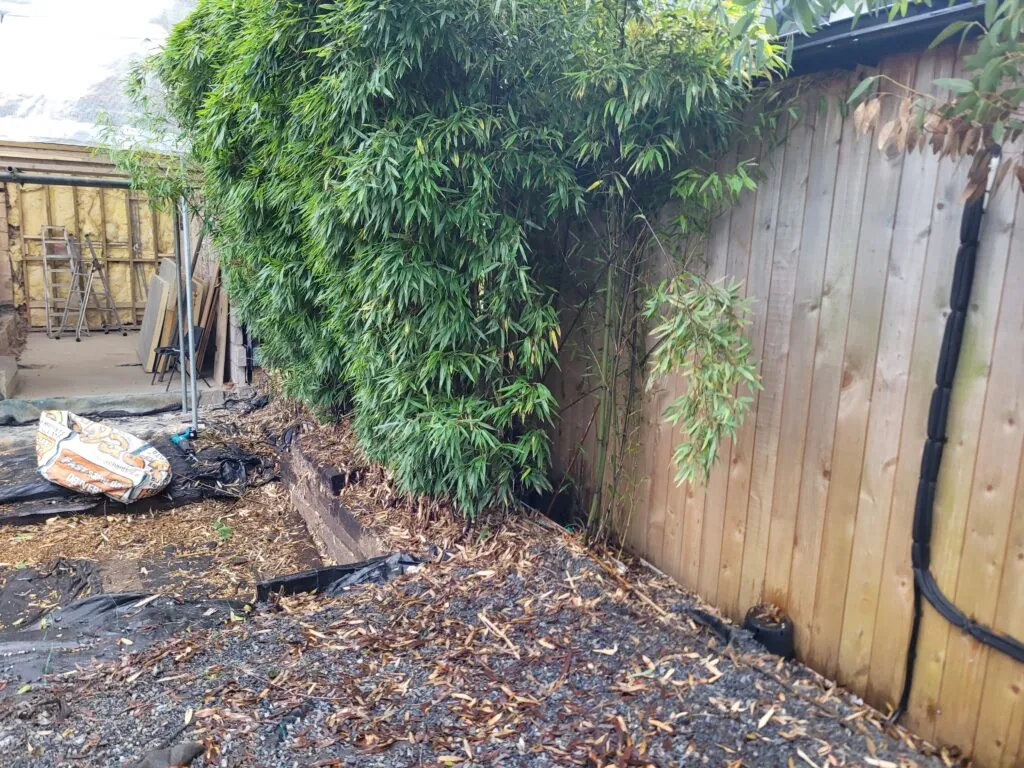
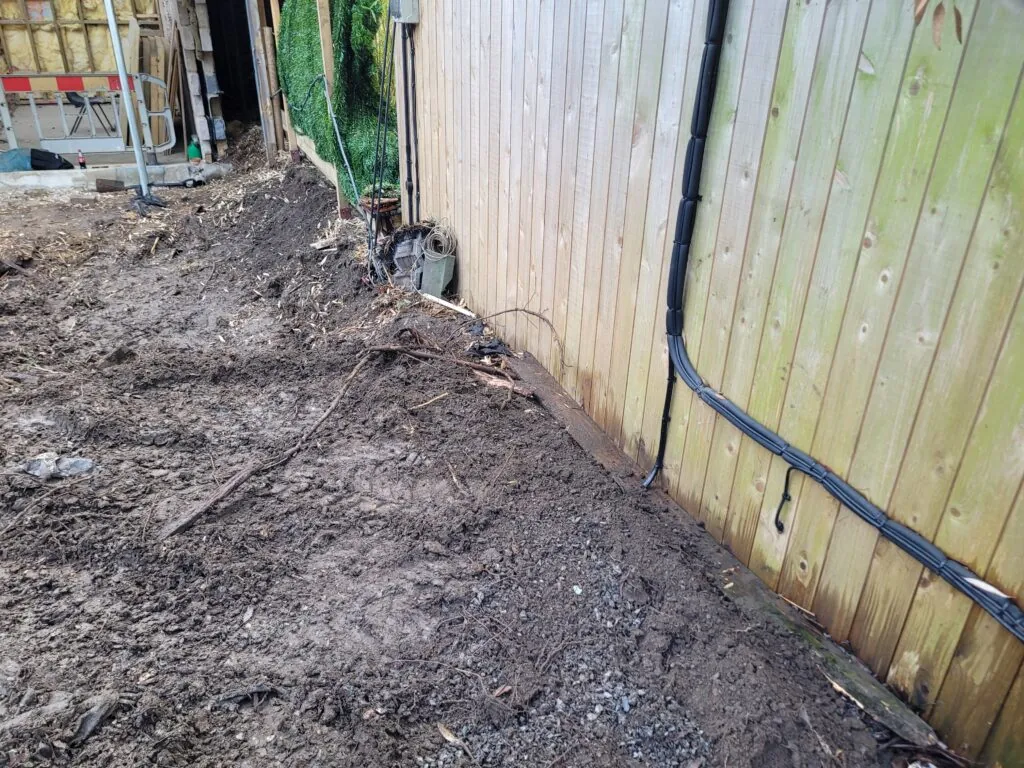
100%
Employee owned
Everyone has a stake in the success of our business
FAQs
Attempts to kill bamboo using herbicide are likely to fail, and often leave behind all the root balls and runners, which take years to decay – leaving an unsightly mess.
If you can manage to remove the root balls, and just have runners left and you want to try to get rid of bamboo yourself then you could try the energy depletion method. This involves cutting any emerging canes to ground level before new leaves appear and repeating the process for many years, in the hope you deplete the energy reserves in the root/rhizome system. In theory, the rhizomes should die off and rot if they are exhausted. In practice, you’ll be at it a long time, so if you feel time may be an issue, you may decide it is time to call in the professionals.
Unfortunately, bamboo does not respect property boundaries. The rhizome system often spreads across boundaries, particularly in small urban or suburban gardens. In such circumstances, it is usually best for the bamboo to be tackled as one, but this relies upon the cooperation of all affected neighbours.
Our consultants will be able to advise you of the best course of action during a survey.
If you are worried about bamboo coming into your property from a neighbour’s garden, see below.
We endeavour to leave your garden neat and tidy on completion, with the soil raked level and anything that we’ve had to remove and reinstate. It’s sometimes the case that we remove so much root mass, that you may need to import some new topsoil to make the levels up. We can generally foresee where this will be required ahead of time and will advise you accordingly.
We generally ask our clients to wait until after the 1st monitoring visit before they replant or cover over any ground that we’ve cleared. This allows us to pick up any small bits that we’ve missed and give you any further recommendations.
Our root barriers are made from a strong, heavy geotextile that is waterproof, resistant to bacteria and most chemicals and it’s completely recyclable. In addition, the root barrier is highly UV resistant so it can be left partially above the soil surface; this makes it easy to prune away the undesired runners that some plants produce. It also includes a 25-year warranty for preventing aggressive roots such as bamboo from growing through it!
- Speak to your neighbour and attempt to resolve the issue amicably. They may not have realised the bamboo has spread or understand the risks posed to both properties.
- Commission a professional to survey the property, to determine the source of the bamboo infestation, the extent of the problem and devise a plan to resolve it. It’s usually best for a bamboo infestation that has spread to multiple properties to be treated as one, but this relies on the cooperation of all the affected neighbours.
- If the neighbour refuses to cooperate, you will need to notify them in writing and ask them to take action to prevent the ‘nuisance’.
- If they still fail to tackle the problem satisfactorily, you may choose to seek legal advice and pursue a claim to recover removal costs, the cost of repairing any damage and your legal costs.
- If a neighbour has bamboo in the garden which is threatening to encroach but has not yet crossed the boundary, alert them to the risks and ask them to remove it or install a root barrier to prevent its spread into your property.
Our prices for bamboo removal start from around £2,300+VAT with typical average costs on a residential bamboo removal sitting somewhere between £4,000-£6,500+VAT although costs can exceed this, particularly where manual removal of bamboo is required.
Bamboo types fall into two categories: running and clumping. Running bamboo spreads aggressively through long rhizomes, while clumping bamboo grows more compactly. https://www.environetuk.com/blog/running-bamboo-vs-clumping-bamboo-should-you-even-bother Identifying features include leaf shape, stem ridges, and rhizome patterns. For a detailed guide, explore Environet’s bamboo identification resources.
Yes, but it’s challenging. Bamboo’s extensive and resilient roots (rhizomes) make removal labor-intensive. Methods include digging out roots, cutting rhizomes, or using chemical treatments. However, missed fragments can regrow, and severe infestations often require professional expertise for complete eradication.
https://www.environetuk.com/blog/bamboo-roots-how-invasive-are-they-and-how-to-manage-them
Signs of bamboo intrusion include shoots appearing near walls or floors, uneven surfaces, or cracks in patios, driveways, or walls. A professional survey can confirm the extent of the spread and assess any potential damage. Learn more about identifying and managing bamboo with Environet’s expert advice.
Bamboo is native to warm, tropical, and temperate regions across Asia, Africa, and the Americas. Its adaptability allows it to thrive in diverse climates, making it a common sight in gardens worldwide. Learn more about bamboo species in our complete guide to bamboo identification.
Yes, most bamboo species are evergreen, maintaining their lush, green foliage throughout the year in the UK climate, making them a popular choice for privacy screens and decorative planting.
Clumping bamboo varieties, such as Fargesia, are safer to grow in the UK as they remain compact and do not spread aggressively like running bamboo. For advice on managing bamboo responsibly, explore our bamboo removal services.
Bamboo heights vary widely depending on the species. In the UK, most garden bamboos reach 3-10 meters, but some tropical species can grow as tall as 40 meters.
Bamboo thrives in diverse soils and climates, commonly growing in tropical and temperate regions. In the UK, it’s often planted in gardens but can become problematic when left unchecked.
Clumping bamboo in the UK grows 1-2 feet annually, while running bamboo can grow 3-4 feet per year and spread several meters via underground rhizomes. If you’re dealing with rapid bamboo spread, our bamboo removal experts can help.
Yes, bamboo is a member of the grass family (Poaceae). Its rapid growth and woody stems make it unique among grasses, but it shares the same fundamental characteristics.
Talk to your neighbour about managing their bamboo and suggest installing a root barrier to prevent spread. Regularly check your side of the boundary, and act quickly if bamboo encroaches onto your property. For expert help, see our bamboo removal services.
You can ask your neighbour to address the encroachment, and if they don’t, legal action for property damage or nuisance may be an option. Document the issue and consider a professional bamboo survey to support your case. Visit our website for guidance.
What our clients say
Reviews
What our clients say
Reviews
Ali Hamaad
“I used Environet following a recommendation to help with invasive Japanese Knotweed in my garden. Very professional, responsive and managed to co-ordinate with other contractors working on my property to remove the knotweed.”
Bernadette Spencer
“Richard was able to book us an assessment visit very quickly regarding the encroachment of evasive running bamboo in our garden .. Will completed the assessment visit,we found him to be very professional, but also friendly and easy to talk to. “
Phil Smith
“This is a very professional operation; always just on the end of the phone. The whole team seemed to know exactly what was going on with the job. (and my neighbours were very happy too.)”
Kim
“I’d just like to take the time to commend the team I have spoken to already, in particular Rachel and Suzie – they have been so friendly, reassuring and informative which has really eased the stress around this situation. Thank you all for your time. .”
L Schjolden
“I would like to commend your man Ed, who was in charge of the works at our property. He was a pleasure to deal with — punctual, polite, professional, responsible. He always kept me up to date with the progress of the works and made sure there was as little disruption to our lives as possible.”
Case Studies

Knutsford, Cheshire

University of Bedfordshire, Bedford

Bamboo removal Earley, Reading

The worst case of property damage by bamboo we’ve ever seen

The worst case of property damage by bamboo we’ve ever seen

Bamboo removal Earley, Reading

Knutsford, Cheshire

University of Bedfordshire, Bedford
GET IN TOUCH
Contact us
Our team of experts is available between 9am and 5:30pm, Monday to Friday to answer your enquiries and advise you on the next steps
Want a survey?
If you already know you have an invasive plant problem, you can request a survey online in less than two minutes by providing a few brief details. A member of the team will swiftly come back to you with further information and our availability.
Need quick plant identification?
Simply upload a few images of your problem plant to our identification form and one of our invasive plant experts will take a look and let you know, free of charge what you are dealing with. We’ll also be there to help with next steps where necessary.



